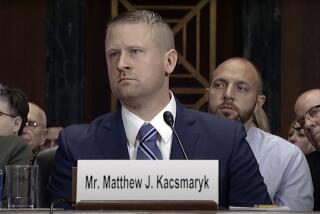Don’t split the 9th Circuit
THE HOUSE of Representatives is mounting a backdoor effort to place a split of the U.S. 9th Circuit Court of Appeals in a budget reduction bill. If successful, this is a “lose-lose” proposition for California and for the consistency of the federal courts on the Pacific Coast.
Clearly, the independence of the judiciary is under attack by those who disagree with some of the court’s rulings. The split would also initially cost an estimated $100 million, because two new and expensive bureaucracies would be needed to administer the courts. And it would cost $16 million more in annual operating expenses. It would also create a huge imbalance in caseloads between the two new circuits, with California’s judges forced to hear many more cases than their peers in other states.
Why is the 9th Circuit so important, and how does it affect our everyday lives? The Supreme Court reviews only 1% of the cases appealed to it. So for most of the residents in the 9th Circuit’s jurisdiction, it is their court of last resort. Last year, the 9th Circuit reviewed more than 15,000 cases, making decisions on every legal issue under the sun, including environmental protection, workplace discrimination, consumer rights, property disputes, fraud and individual freedoms. Moreover, these decisions affect not only the rights of those whose cases are argued before the 9th Circuit, they shape the law for all those who follow.
The founders designed our federal courts to be independent decision-making bodies, free of political pressure. The House’s effort to split the 9th Circuit is an assault on this independence.
It is judicial “gerrymandering” designed to isolate and punish judges. This is a partisan effort to redraw the boundaries of the circuit courts to create a much more conservative bench in the proposed 12th Circuit.
Where do things stand now? On Nov. 3, while considering a $53.9-billion package of mandatory spending cuts, the House Budget Committee approved a proposal to break up the 9th Circuit -- an act that will add to, not subtract from, our nation’s deficit.
The full House is expected to consider this measure next week. It would then go to a House-Senate conference committee to work out differences with the budget bill already approved by the Senate, which does not include the split.
The proposal would split the 9th Circuit into a new 9th Circuit, made up of California, Hawaii, Guam and the Northern Mariana Islands, and a new 12th Circuit, made up of Arizona, Nevada, Idaho, Montana, Oregon, Washington and Alaska. This split would create a dramatic imbalance in caseloads between the two circuits. About 72% of the caseload would remain in the 9th Circuit, but only 60% of the judges. The new 9th Circuit would have an average of 536 cases per judge, compared with only 317 cases in the proposed 12th Circuit.
This unfair division of resources would leave residents of California and Hawaii facing greater delays, as well as court services inferior to their 12th Circuit neighbors.
Those who know the 9th Circuit best oppose a split. Only three of the 24 active judges on the 9th Circuit favor splitting it. Additionally, the state bar associations that have weighed in on the split -- Arizona, Washington, Montana and Hawaii -- oppose it.
If there is to be a debate about splitting the 9th Circuit, putting the proposal in a budget bill does not give the issue the consideration it deserves. It also comes during the period that the Senate Judiciary Committee is exploring a number of proposals regarding the 9th Circuit, and that review should be allowed to run its course.
If a split remains in the conference committee report when it comes back to the Senate, it will leave Sen. Barbara Boxer and me with no other alternative but to raise a point of order, which would require supporters of the split to get 60 votes to keep the measure in the bill. This could bring down the entire bill, so it is my hope that cooler heads will prevail and the split will be removed from a bill where it does not belong.
DIANNE FEINSTEIN is California’s senior U.S. senator.
More to Read
Get the L.A. Times Politics newsletter
Deeply reported insights into legislation, politics and policy from Sacramento, Washington and beyond. In your inbox three times per week.
You may occasionally receive promotional content from the Los Angeles Times.










